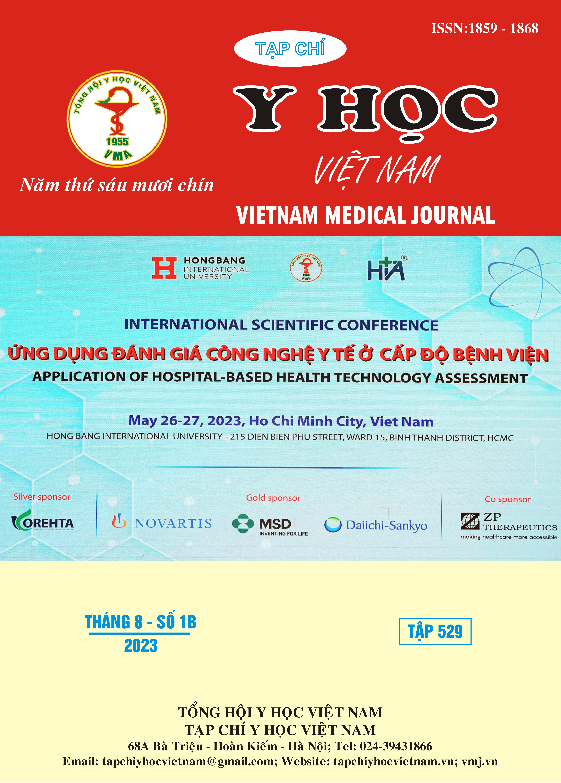STUDY ON DRUG RESISTANCE MUTATIONS OF HEPATITIS B VIRUS IN CHRONIC HEPATITIS B PATIENTS AT CAN THO UNIVERSITY HOSPITAL OF MEDICINE AND PHARMACY IN 2022-2023
Main Article Content
Abstract
Background: Currently, many types of resistance mutations of HBV have been detected and these mutations lead to treatment failure, so testing to identify resistance genes has strategic implications for the treatment and management of chronic hepatitis B. Objective: Determination of the rate of drug-resistant mutations of hepatitis B virus in patients with chronic hepatitis B and understanding factors associated with drug-resistant mutations of hepatitis B virus in patients with chronic hepatitis B. Materials and methods: A cross-sectional descriptive study was conducted on 71 patients determined with chronic hepatitis B with indications for liver enzyme testing, serological markers at CanTho University of Medicine and Pharmacy, serum samples compiled for viral load analysis and genomic sequencing at Nam Khoa laboratory. Results: There were 71 chronic hepatitis B patients studied, of which males predominate (53.5%), with the mean age of patients being 40.6±15.7. Most of the study subjects had liver enzyme results within the normal range of GOT (56.3%), and GPT (69.0%). Regarding the immune marker HBeAg (+) accounting for 54.9%, HBeAg (-) was 45.1%, all cases had HBV DNA (+) the majority of cases had viral load >20000 IU/mL (78.9%). There are only 2 genotypes B and C, of which genotype B accounts for 73.2% and C is 26.8%. The rate of antimicrobial resistance mutations of HBV is 7.0%, of which LAM (V207M), resistance mutations are 2.8%, ADV (Q215H) 2,8%, ETV (S202I) 1.4%. No association has been found between age, sex, HBeAg status, and HBV DNA with hepatitis B virus resistance. Conclusions: Testing for drug-resistant mutations of the hepatitis B virus in patients with chronic hepatitis B is important for effective management, monitoring, and treatment
Article Details
Keywords
Chronic hepatitis B virus, genotypes, resistance mutation, viral load
References
1. Trịnh Thị Hằng (2019), Xác định đột biến kháng thuốc liên quan đến đột biến ở bệnh nhân viêm gan B mạn tại bệnh viện Bệnh Nhiệt đới Trung ương từ tháng 1 năm 2014 đến tháng 12 năm 2017, Đại Học Y Hà Nội.
2. Alacam S., Karabulut N., Yolcu A., et al (2019), "Evaluation of drug resistance mutations in patients with chronic hepatitis B", Folia Microbiol (Praha), 64(2), pp.237-243.
3. EASL (2017), "EASL 2017 Clinical Practice Guidelines on the management of hepatitis B virus infection", J Hepatol, 67(2), pp.370-398.
4. Guo X., Wu J., Wei F., et al (2018), "Trends in hepatitis B virus resistance to nucleoside/nucleotide analogues in North China from 2009-2016: A retrospective study", Int J Antimicrob Agents, 52(2), pp.201-209.
5. Lun-Gen L. (2014), "Antiviral therapy of liver cirrhosis related to hepatitis B virus infection", Journal of Clinical and Translational Hepatology, 2, pp.197-201.
6. Ming-Chun L., Jiang-Shan L., Wen-Jin Z., et al (2020), "Compare with safety and efficacy of entecavir and adefovir dipivoxil combination therapy and tenofovir disoproxil fumarate monotherapy for chronic hepatitis B patient with adefovir-resistant", Mathematical Biosciences and Engineering, 17(1), pp.627-635.
7. Thi Ton That Bui, Tan Thanh Tran, My Ngoc Nghiem, et al (2017), "Molecular characterization of hepatitis B virus in Vietnam", BMC Infect Dis, 17(1), pp.601-610.
8. Thu Kim Nguyen, Duyet Van Le (2023), "Resistant mutations within the hepatitis B virus reverse transcriptase sequence in treatment failure patients with chronic HBV infection in Vietnam", J Glob Antimicrob Resist, 33, pp.35-41.


